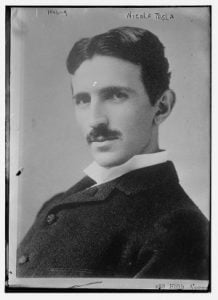
The inventor’s vision of a global wireless-transmission tower proved to be his undoing.
Image Courtesy of Library of Congress
Authored by Gilbert King
By the end of his brilliant and tortured life, the Serbian physicist, engineer and inventor Nikola Tesla was penniless and living in a small New York City hotel room. He spent days in a park surrounded by the creatures that mattered most to him—pigeons—and his sleepless nights working over mathematical equations and scientific problems in his head. That habit would confound scientists and scholars for decades after he died, in 1943. His inventions were designed and perfected in his imagination.
Tesla believed his mind to be without equal, and he wasn’t above chiding his contemporaries, such as Thomas Edison, who once hired him. “If Edison had a needle to find in a haystack,” Tesla once wrote, “he would proceed at once with the diligence of the bee to examine straw after straw until he found the object of his search. I was a sorry witness of such doing that a little theory and calculation would have saved him ninety percent of his labor.”
But what his contemporaries may have been lacking in scientific talent (by Tesla’s estimation), men like Edison and George Westinghouse clearly possessed the one trait that Tesla did not—a mind for business. And in the last days of America’s Gilded Age, Nikola Tesla made a dramatic attempt to change the future of communications and power transmission around the world. He managed to convince J.P. Morgan that he was on the verge of a breakthrough, and the financier gave Tesla more than $150,000 to fund what would become a gigantic, futuristic and startling tower in the middle of Long Island, New York. In 1898, as Tesla’s plans to create a worldwide wireless transmission system became known, Wardenclyffe Tower would be Tesla’s last chance to claim the recognition and wealth that had always escaped him.
Nikola Tesla was born in modern-day Croatia in 1856; his father, Milutin, was a priest of the Serbian Orthodox Church. From an early age, he demonstrated the obsessiveness that would puzzle and amuse those around him. He could memorize entire books and store logarithmic tables in his brain. He picked up languages easily, and he could work through days and nights on only a few hours sleep.
At the age of 19, he was studying electrical engineering at the Polytechnic Institute at Graz in Austria, where he quickly established himself as a star student. He found himself in an ongoing debate with a professor over perceived design flaws in the direct-current (DC) motors that were being demonstrated in class. “In attacking the problem again I almost regretted that the struggle was soon to end,” Tesla later wrote. “I had so much energy to spare. When I undertook the task it was not with a resolve such as men often make. With me it was a sacred vow, a question of life and death. I knew that I would perish if I failed. Now I felt that the battle was won. Back in the deep recesses of the brain was the solution, but I could not yet give it outward expression.”
He would spend the next six years of his life “thinking” about electromagnetic fields and a hypothetical motor powered by alternate-current that would and should work. The thoughts obsessed him, and he was unable to focus on his schoolwork. Professors at the university warned Tesla’s father that the young scholar’s working and sleeping habits were killing him. But rather than finish his studies, Tesla became a gambling addict, lost all his tuition money, dropped out of school and suffered a nervous breakdown. It would not be his last.
In 1881, Tesla moved to Budapest, after recovering from his breakdown, and he was walking through a park with a friend, reciting poetry, when a vision came to him. There in the park, with a stick, Tesla drew a crude diagram in the dirt—a motor using the principle of rotating magnetic fields created by two or more alternating currents. While AC electrification had been employed before, there would never be a practical, working motor run on alternating current until he invented his induction motor several years later.
In June 1884, Tesla sailed for New York City and arrived with four cents in his pocket and a letter of recommendation from Charles Batchelor—a former employer—to Thomas Edison, which was purported to say, “My Dear Edison: I know two great men and you are one of them. The other is this young man!”
A meeting was arranged, and once Tesla described the engineering work he was doing, Edison, though skeptical, hired him. According to Tesla, Edison offered him $50,000 if he could improve upon the DC generation plants Edison favored. Within a few months, Tesla informed the American inventor that he had indeed improved upon Edison’s motors. Edison, Tesla noted, refused to pay up. “When you become a full-fledged American, you will appreciate an American joke,” Edison told him.
Tesla promptly quit and took a job digging ditches. But it wasn’t long before word got out that Tesla’s AC motor was worth investing in, and the Western Union Company put Tesla to work in a lab not far from Edison’s office, where he designed AC power systems that are still used around the world. “The motors I built there,” Tesla said, “were exactly as I imagined them. I made no attempt to improve the design, but merely reproduced the pictures as they appeared to my vision, and the operation was always as I expected.”
Tesla patented his AC motors and power systems, which were said to be the most valuable inventions since the telephone. Soon, George Westinghouse, recognizing that Tesla’s designs might be just what he needed in his efforts to unseat Edison’s DC current, licensed his patents for $60,000 in stocks and cash and royalties based on how much electricity Westinghouse could sell. Ultimately, he won the “War of the Currents,” but at a steep cost in litigation and competition for both Westinghouse and Edison’s General Electric Company.
Fearing ruin, Westinghouse begged Tesla for relief from the royalties Westinghouse agreed to. “Your decision determines the fate of the Westinghouse Company,” he said. Tesla, grateful to the man who had never tried to swindle him, tore up the royalty contract, walking away from millions in royalties that he was already owed and billions that would have accrued in the future. He would have been one of the wealthiest men in the world—a titan of the Gilded Age.
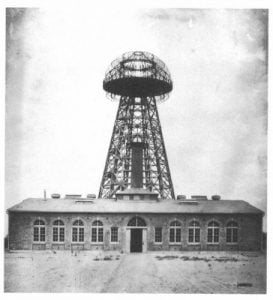 Wardenclyffe Tower
Wardenclyffe Tower
His work with electricity reflected just one facet of his fertile mind. Before the turn of the 20th century, Tesla had invented a powerful coil that was capable of generating high voltages and frequencies, leading to new forms of light, such as neon and fluorescent, as well as X-rays. Tesla also discovered that these coils, soon to be called “Tesla Coils,” made it possible to send and receive radio signals. He quickly filed for American patents in 1897, beating the Italian inventor Guglielmo Marconi to the punch.
Tesla continued to work on his ideas for wireless transmissions when he proposed to J.P. Morgan his idea of a wireless globe. After Morgan put up the $150,000 to build the giant transmission tower, Tesla promptly hired the noted architect Stanford White of McKim, Mead, and White in New York. White, too, was smitten with Tesla’s idea. After all, Tesla was the highly acclaimed man behind Westinghouse’s success with alternating current, and when Tesla talked, he was persuasive.
“As soon as completed, it will be possible for a business man in New York to dictate instructions, and have them instantly appear in type at his office in London or elsewhere,” Tesla said at the time. “He will be able to call up, from his desk, and talk to any telephone subscriber on the globe, without any change whatever in the existing equipment. An inexpensive instrument, not bigger than a watch, will enable its bearer to hear anywhere, on sea or land, music or song, the speech of a political leader, the address of an eminent man of science, or the sermon of an eloquent clergyman, delivered in some other place, however distant. In the same manner any picture, character, drawing or print can be transferred from one to another place. Millions of such instruments can be operated from but one plant of this kind.”
White quickly got to work designing Wardenclyffe Tower in 1901, but soon after construction began it became apparent that Tesla was going to run out of money before it was finished. An appeal to Morgan for more money proved fruitless, and in the meantime investors were rushing to throw their money behind Marconi. In December 1901, Marconi successfully sent a signal from England to Newfoundland. Tesla grumbled that the Italian was using 17 of his patents, but litigation eventually favored Marconi and the commercial damage was done. (The U.S. Supreme Court ultimately upheld Tesla’s claims, clarifying Tesla’s role in the invention of the radio—but not until 1943, after he died.) Thus the Italian inventor was credited as the inventor of radio and became rich. Wardenclyffe Tower became a 186-foot-tall relic (it would be razed in 1917), and the defeat—Tesla’s worst—led to another of his breakdowns. ”It is not a dream,” Tesla said, “it is a simple feat of scientific electrical engineering, only expensive—blind, faint-hearted, doubting world!”
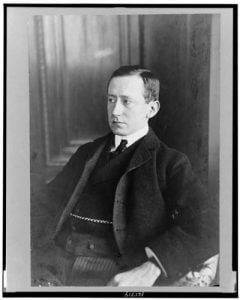
Guglielmo Marconi in 1903 from Library of Congress
By 1912, Tesla began to withdraw from that doubting world. He was clearly showing signs of obsessive-compulsive disorder, and was potentially a high-functioning autistic. He became obsessed with cleanliness and fixated on the number three; he began shaking hands with people and washing his hands—all done in sets of three. He had to have 18 napkins on his table during meals, and would count his steps whenever he walked anywhere. He claimed to have an abnormal sensitivity to sounds, as well as an acute sense of sight, and he later wrote that he had “a violent aversion against the earrings of women,” and “the sight of a pearl would almost give me a fit.”
Near the end of his life, Tesla became fixated on pigeons, especially a specific white female, which he claimed to love almost as one would love a human being. One night, Tesla claimed the white pigeon visited him through an open window at his hotel, and he believed the bird had come to tell him she was dying. He saw “two powerful beams of light” in the bird’s eyes, he later said. “Yes, it was a real light, a powerful, dazzling, blinding light, a light more intense than I had ever produced by the most powerful lamps in my laboratory.” The pigeon died in his arms, and the inventor claimed that in that moment, he knew that he had finished his life’s work.
Nikola Tesla would go on to make news from time to time while living on the 33rd floor of the New Yorker Hotel. In 1931 he made the cover of Time magazine, which featured his inventions on his 75th birthday. And in 1934, the New York Times reported that Tesla was working on a “Death Beam” capable of knocking 10,000 enemy airplanes out of the sky. He hoped to fund a prototypical defensive weapon in the interest of world peace, but his appeals to J.P. Morgan Jr. and British Prime Minister Neville Chamberlain went nowhere. Tesla did, however, receive a $25,000 check from the Soviet Union, but the project languished. He died in 1943, in debt, although Westinghouse had been paying his room and board at the hotel for years.
Source: Tesla
Disclaimer: We at Prepare for Change (PFC) bring you information that is not offered by the mainstream news, and therefore may seem controversial. The opinions, views, statements, and/or information we present are not necessarily promoted, endorsed, espoused, or agreed to by Prepare for Change, its leadership Council, members, those who work with PFC, or those who read its content. However, they are hopefully provocative. Please use discernment! Use logical thinking, your own intuition and your own connection with Source, Spirit and Natural Laws to help you determine what is true and what is not. By sharing information and seeding dialogue, it is our goal to raise consciousness and awareness of higher truths to free us from enslavement of the matrix in this material realm.
 EN
EN FR
FR

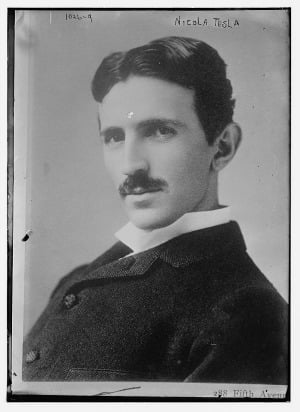

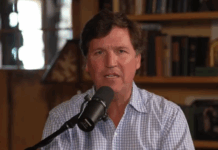





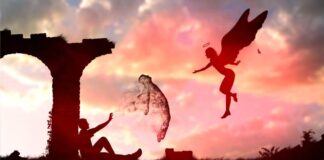
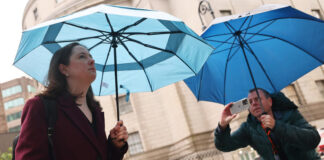

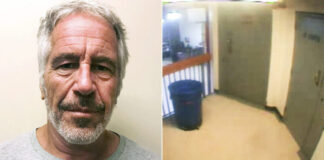
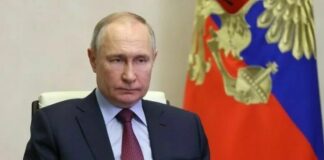













Incredible visionary.